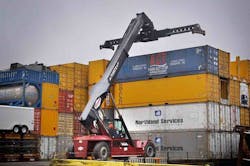Cummins Integrating Hydrogen Engines into Taylor Heavy Industrial Lift Trucks
Power equipment firm Cummins will integrate its hydrogen engines into Taylor Machine Works’ heavy industrial lift machines, according to a new agreement announced Thursday.
The two American firms will partner on ways of decarbonizing the materials handling sector. Taylor Machine Works makes equipment such as forklifts and generators for agricultural, industrial, and distribution operations.
Cummins signed the letter of intent on plans to integrate its 6.7 and 15-liter hydrogen engines into the Taylor product line. Hydrogen is an energy dense gas which does not include carbon in its chain and therefore does not emit carbon dioxide when combusted.
Cummins Engines already power many of Taylor’s heavy lift trucks. The transition to hydrogen and electrification could assist in decarbonizing industries such as steel, wood, concrete, oil and gas, and port operations.
“This partnership signifies our commitment to a sustainable future, enabling us to offer reliable, cost-effective, zero-carbon solutions for heavy industry lift equipment, reducing carbon emissions without compromising productivity,” Matt Hillyer, Taylor’s Director of Engineering, said in a statement.
Cummins has engaged in work on H2 equipment for years. The company already produces a number of proton exchange membrane electrolyzers. Electrolyzers use an electrical process to separate hydrogen from water.
Many in the energy transition movement want to create green hydrogen, which would be produced by electrolyzers powered by carbon-free resources such as solar, wind, nuclear, and hydro. Hydrogen also can be produced by steam reforming of methane gas, but that is carbon intensive.
Hydrogen also is the lightest gas and considerably more flammable than gasoline, methane gas, or propane.
“Cummins is pleased to be working with Taylor Machine Works on hydrogen solutions for their equipment,” said Antonio Leitao, Vice President of Cummins’ off-highway engine business. “We see hydrogen internal combustion engines as a solution to help drive sustainability improvements in our industry. Hydrogen power will help both OEMS (original equipment manufacturers) and end-users looking to making carbon emissions reductions on their paths to zero.”
Track News about the C&I Energy Transition Worldwide. Subscribe to the free EnergyTech Newsletter
About the Author
Rod Walton, EnergyTech Managing Editor
Managing Editor
For EnergyTech editorial inquiries, please contact Managing Editor Rod Walton at [email protected].
Rod Walton has spent 17 years covering the energy industry as a newspaper and trade journalist. He formerly was energy writer and business editor at the Tulsa World. Later, he spent six years covering the electricity power sector for Pennwell and Clarion Events. He joined Endeavor and EnergyTech in November 2021.
Walton earned his Bachelors degree in journalism from the University of Oklahoma. His career stops include the Moore American, Bartlesville Examiner-Enterprise, Wagoner Tribune and Tulsa World.
EnergyTech is focused on the mission critical and large-scale energy users and their sustainability and resiliency goals. These include the commercial and industrial sectors, as well as the military, universities, data centers and microgrids. The C&I sectors together account for close to 30 percent of greenhouse gas emissions in the U.S.
He was named Managing Editor for Microgrid Knowledge and EnergyTech starting July 1, 2023
Many large-scale energy users such as Fortune 500 companies, and mission-critical users such as military bases, universities, healthcare facilities, public safety and data centers, shifting their energy priorities to reach net-zero carbon goals within the coming decades. These include plans for renewable energy power purchase agreements, but also on-site resiliency projects such as microgrids, combined heat and power, rooftop solar, energy storage, digitalization and building efficiency upgrades.

